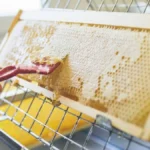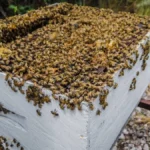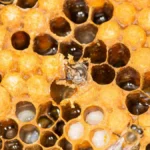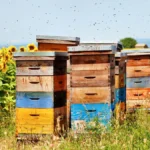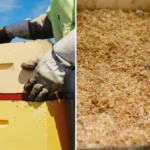How many bees are in a hive box? This is a bit like asking how many people are in a city!! There is however a relatively easy way to work the answer to this out. Hives can range in size from 500 bees to over 100 000 bees in exceptional cases. This article will show you how to calculate bee numbers roughly.
How Do You Calculate How Many Bees Are In A Hive Box?
I used to have to determine how many bees are in a hive box for a holiday job when I was a student!! The easiest way is to go to the hive in the late evening, smoke the hive so they are calm, and then empty the entire hive into a box for which you know the weight. We had a box with a double flap entrance door so bees could not crawl out. You have now removed the bees from the combs.
The next thing you do is to weigh the box – subtract the mass of the box from the mass of the box with bees. I am going to do this in kilograms, as trying to work stuff like this out in pounds is just impossible. Scientific papers globally use metric measures for this reason. Let us say the weight of bees is 1800 grams.

Learn more about: Beehive Entrance Reducer Dimensions
Take a sample of about 100 bees. This was what I had to do – you can get away with taking 10 bees if you want to be less accurate. Place the bottle of bees in the fridge until the bees lose the ability to fly (ie they are cold – they will warm up again don’t worry). Weigh bees and record their weight. You need an accurate scale to weigh bees – the cheapest scale accurate to three decimal places is a bullet reloading scale such as this one. These are good scales, and you can get a pretty accurate weight for a bee on it. (make sure it is on g which is grams, not gn which is grains).
Work out the average weight of a bee by weighing 10 or 100 bees and adding the mass of bees up and then dividing by either 10 or 100 depending on how many you weighed.
In my area, the bees weigh about 0,09 to 0,1g/bee. 1800g ,1g=18 000 bees. For most bees around the world, the bees are a bit heavier at 0,11g to 0,12g so that would be around 15 000 bees a kg or 6800 bees a pound. The general rule of thumb seems to be that there are about 3000-5000 bees per pound. This seems to be quite a discrepancy. Nevertheless, you have now worked out how many bees are in a hive box to a high level of accuracy.
How Do You Calculate How Many Bees Are In A Swarm?
This is much easier than for a hive and I also had to do this a lot as a student. We had a special bucket with a gauze mesh on the side. The weight of the bucket was actually written on the side. We would dump the bees in the bucket, close the lid and weigh them.
The same formula as above gives you a rough indication of how many bees are in a hive box/swarm. Bees in swarms tend to have a higher average weight because they have full honey stomachs.
What Is The Minimum Number Of Bees In A Hive?
This will really depend on the time of year, ambient temperature, and so on. I have seen very small clusters of bees – 200 or 300 bees, that have moved into a post box in the middle of summer and built up into decent hives. This does require a strong honey flow.
Bees get old and die, and a certain number are needed to make wax, feed baby bees and ventilate the hive. In order for the hive to grow, you need enough bees to be able to forage, build, feed, process, and so on. We tend to find that you reach a number of bees below for which it is just not possible for the bees to build up, and the bees cannot survive.
I once had a little swarm of bees that settled into an upturned pot in the garden. This handful of bees – probably 100 or so, struggled for the season. I would actually go and feed them honey at night to try and help them. They slowly built up to the point where they had a few little combs in the pot – and then as the weather cooled going into winter they just froze to death at night. It was sad.
I would say that to be safe, you would need at least 1000 bees as a bare minimum in a nucleus box in order to have a hope of actually getting the hive strong in time for winter. This would really be a push and will require decent working on the hive and a bit of feeding.
If you start a hive with 2000-3000 bees you have the critical mass needed to produce a decent-sized hive by fall. This is why most package bees come in at least 1lb units. Anything less than this is just a waste of time, money, and space as they will not be able to establish a sustainable bee colony.
How Much Honey Will A Beehive Produce?
This is a bit like asking how much money a person will make in their life. Elon Musk and I are about the same age. I have made 0,00000667 times as much money as he has!!! My calculation is probably out by a decimal place or two, but the point is, much like humans, some beehives are just a whole lot more talented than others. And some beehives are good beehives in the right place at the right time, and others are good beehives in the wrong place at the wrong time. Some hives are just downright untalented and will do badly in amazing times.
All the philosophy aside – a good beehive in a good honey flow can produce crops of 100-300 pounds with ease if well managed. I have seen hives produce over 1000 pounds on Eucalyptus, and 500 pounds on citrus.
There is a dangerous problem that happens with any business planning exercise where people get ahead of themselves in calculating how much honey they can produce and how much money they can make. If you become an Excell Spreadsheet millionaire in your business plan based on the fact that you harvested 100 lb a hive off two hives in your back yard in one year, and then extrapolate this to 1000 hives……you will be disappointed. Large-scale beekeeping is generally less productive than backyard beekeeping.
Learn more about: How Much Does It Cost To Start A Bee Farm?
How do you calculate how many bees are in a hive box? Now you know! Weigh the total mass of bees, weigh a sample of individual bees, work out their average mass and then divide the mass of bees by the average mass of a bee. I enjoyed this article and looking at bee numbers – took me back to student days measuring boxes of angry bees. If you enjoyed the article, please share.
How Many Bees in a Hive FAQs
1. How many bees are in a typical hive box?
A typical hive box can contain anywhere between 20,000 and 60,000 bees, depending on the hive’s size, season, and the strength of the colony.
2. What is the minimum number of bees needed to start a hive?
A successful hive generally needs at least 3,000–5,000 bees to get started. Smaller colonies may struggle to build up enough strength to survive.
3. How do you calculate the number of bees in a hive?
You can calculate the number of bees by weighing the colony and then dividing by the average weight of a single bee, which is approximately 0.1 grams.
4. How many bees are in a pound?
On average, there are about 3,500–4,000 bees per pound.
5. How does the population of bees in a hive fluctuate throughout the year?
Bee populations grow in spring and summer when there are more resources available, peaking at 50,000–60,000 bees. In winter, the population drops to around 10,000–20,000 as the hive conserves energy.
6. Can a hive survive with a very small number of bees?
A small cluster of 200–300 bees may struggle to survive, especially in cold weather. A hive typically needs at least 1,000–3,000 bees to maintain functionality.
7. How much honey does a typical hive produce?
A well-managed hive can produce 50–100 pounds of honey per season. Exceptional hives may yield even more, depending on conditions.
8. How long does it take for a new bee colony to grow?
Under optimal conditions, a new colony can grow to full strength in a few months, provided they have access to plenty of nectar and pollen.
9. What factors influence how many bees are in a hive?
The queen’s productivity, available food, environmental conditions, and overall hive health all influence bee population size.
10. What happens if a hive has too many bees?
If a hive becomes overcrowded, the colony may swarm, where a portion of the bees, including the queen, leave to form a new colony elsewhere.

Dr. Garth A. Cambray is a Canadian/South African entrepreneur and beekeeper with 28 years of experience in apiculture and specializes in adding value to honey. His Ph.D. research developed a new advanced continuous fermentation method for making mead that has resulted in a number of companies globally being able to access markets for mead. His company, Makana Meadery, exports honey mead to the USA where it is available to discerning connoisseurs. He has also developed technologies to commercially manufacture organic honey vinegar in Zambia for export globally. He holds a few patents globally in the ethanol industry and believes in technology and knowledge transfer for human development and environmental sustainability. One of his proudest achievements is the fact that the wind farm he started at one of his old apiary sites has essentially made his hometown carbon neutral.

